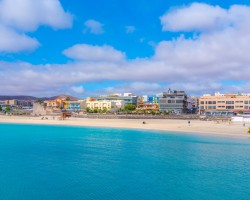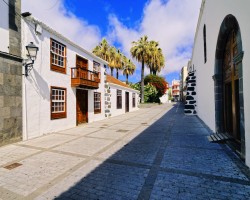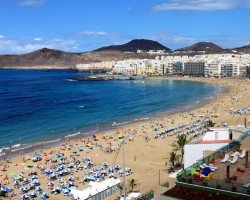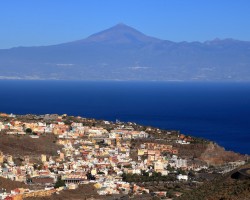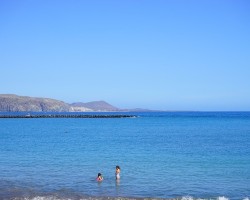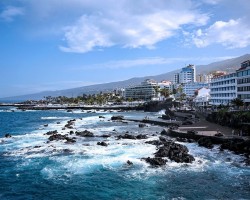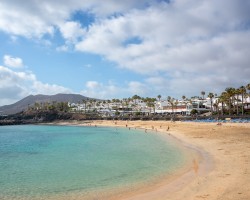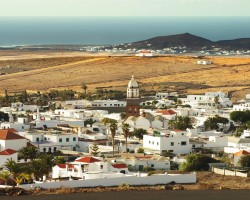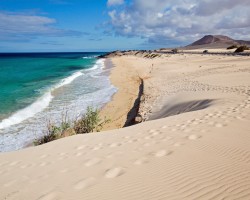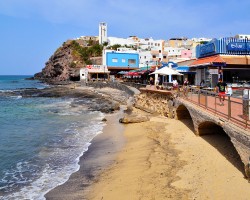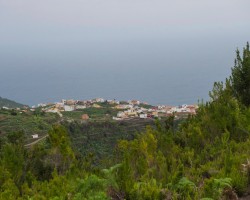Best time to go to the Canary Islands for a perfect weather and where to go?
When is the best time to go to the Canary Islands?
The Canary Islands benefit from a mild climate all year round. Therefore, it is possible to travel there in any season and find perfect weather conditions.
However, the best time to visit the Canary Islands is between May and November. The temperatures are warmer, the weather is very sunny, and rainfall is almost non-existent.
During this period, the temperature ranges between 20 and 28 °C on average. It's pleasant, but never too hot. Moreover, summer is when the sea is the warmest for swimming on these islands.
Nevertheless, winter is also a pleasant season. Temperatures range between 18 and 21 °C. Although there might be some passing showers, the weather is very sunny.
With this eternal spring-like climate, tourist influx is high all year round in the Canary Islands.
If you're wondering when to visit the Canary Islands to avoid the crowds, note that July and August are busier as well as December and January. Many travelers seek to enjoy the year-end holidays in the sun.
During these peak tourist periods, flights and accommodations also become more expensive and should be booked in advance.
Therefore, traveling to the Canary Islands during spring and autumn can be an excellent idea. The islands still enjoy the same pleasant weather, but there is a quieter atmosphere. Prices are also lower.
The months of May to June and September to November will be perfect for planning your trip! You will find ideal weather conditions and attractive offers.
Where and when to go based on the weather?
El Hierro
Valverde, La Restinga, Sabinosa...
Fuerteventura
Puerto del Rosario, Corralejo, Morro Jable...
Gomera
San Sebastián de La Gomera, Vallehermoso, Playa Santiago...
Gran Canaria
Las Palmas de Gran Canaria, Maspalomas, Agaete...
La Palma
Los Llanos de Aridane, Los Sauces, Los Canarios...
Lanzarote
Arrecife, Playa Blanca, Teguise...
Tenerife
Santa Cruz de Tenerife, Puerto de la Cruz, Playa de las Américas...
To get all the information about the climate and weather in the Canary Islands for a specific month, click on the corresponding link below:
Canary Islands in january Canary Islands in february Canary Islands in march Canary Islands in april Canary Islands in may Canary Islands in june Canary Islands in july Canary Islands in august Canary Islands in september Canary Islands in october Canary Islands in november Canary Islands in december
Best time to travel to Canary Islands by cities
Climate and Weather in the Canary Islands
The Canary Islands form an archipelago constituting an autonomous community of Spain. They are located in the heart of the Atlantic Ocean, off the coast of Morocco. The archipelago consists of seven main islands: Lanzarote, Fuerteventura, Tenerife, Gran Canaria, La Gomera, La Palma, and El Hierro. However, there are also many smaller islands.
The climate of the Canary Islands is subtropical with consistently pleasant temperatures, many sunny days, and low rainfall.
The temperature variations are moderate throughout the year: it is around 20 to 30 °C all year round. However, temperatures can be cooler in the mountainous areas located in the center of some islands. It can even snow above 1,900 meters in altitude, such as in the caldera of the El Teide volcano in Tenerife.

Climate of the Canary Islands in Winter
The weather in the Canary Islands is mild from November to February with temperatures ranging from 18 to 22 °C. Although this season is relatively sunny, it is the time when precipitation is most frequent. For example, from December to February, one can expect 5 days of rain per month. Indeed, showers are often seen in the late afternoon, but it is rare for it to rain all day.
In the highlands, temperatures can drop drastically and even go below 0°C. Therefore, warm clothing should be brought along to visit Teide National Park or for hiking in the center of La Palma.
Climate of the Canary Islands in Summer
In summer, the climate of the Canary Islands is hot and dry. Temperatures range between 23 and 28 °C on average, but can exceed 30 °C at times. Indeed, warm winds from the Sahara can blow over the islands, leading to heatwaves. The mercury can reach 35 °C in El Hierro or 40 °C in Tenerife and Lanzarote.
Moreover, precipitation is very low during this period. June and July are in fact the driest months of the year. It is not uncommon for not a single drop of rain to fall during these two months.
Furthermore, during the summer, even if the climate is mostly sunny, the sky is often hazy. Therefore, one must pay particular attention to sunburn. Indeed, the UV index is very high on these islands even when the weather seems cloudy.
Summer is also the best time to enjoy the beaches and surf spots in the Canary Islands. If the sea temperature ranges between 20 and 24 °C on these islands, it is in summer that it is the warmest. Swimming is thus particularly pleasant from August to October.
Climate of the Canary Islands: Autumn and Spring
Autumn and spring are pleasant and low-rainfall periods. From April to June, temperatures range between 19 and 23 °C, while in autumn, they range between 23 and 27 °C. Moreover, less than 30 mm of rain falls per month on average during these seasons.
Thus, the weather in the Canary Islands is very mild during these periods. November, however, can be quite rainy on some islands.
Climate Diversity Across the Canary Islands
The Canary Islands have diverse climates depending on the regions. Indeed, on the islands of Tenerife and El Hierro, there are mountainous areas inland. This leads to microclimates where it is cooler and more humid.
For example, in Tenerife, the north of the island is often colder and more exposed to bad weather than the south.
- For instance, in San Cristóbal de La Laguna, located at 600m altitude, temperatures range from 22 to 25°C in July and 40 mm of precipitation in November.
- While in the seaside resort of Los Cristianos, further south, temperatures range from 25 to 28 °C in July and 20 mm of precipitation in November.
Furthermore, the islands of Fuerteventura and Lanzarote have lower altitudes. Thus, they have a quasi-desert climate and are very sunny. The trade winds blow constantly on these islands, making them ideal for surfing.
However, in La Palma, which has mountainous areas exceeding 2,000 m in altitude, a colder climate is found. It is the greenest and therefore the rainiest island in the Canaries.
But this fact should not deter you from planning your trip. Indeed, on the coasts, the climate remains very pleasant and fairly dry throughout the year. One can therefore enjoy the beaches without worry.
Temperatures and rainfall in the Canary Islands
On these 3 graphs, we present the evolution of temperatures of Canary Islands and month-by-month rainfall for the cities of Santa Cruz de Tenerife, Arrecife, Puerto del Rosario, Los Llanos de Aridane and Las Palmas de Gran Canaria, as well as the month-by-month sea temperature for coastal cities.
Peak visitor numbers and tourist seasons in the Canary Islands
Find out when Canary Islands has its high tourist season (the period when the influx of tourists is highest) and off-peak tourist season using our data and figures.
Tourist seasons in the Canary Islands
The months with low numbers of tourists are: March, April, May, June, September and November. The number of visitors to Canary Islands is high in: January, February, July, August, October and December.
- Very low season in the Canary Islands: March, April, May, June, September and November.
- Peak season in the Canary Islands: January, February, July, August, October and December.
Figure: Visitor index for Canary Islands month by month
Average price for flights to the Canary Islands
A return flight between Manchester and Tenerife is generally cheaper if you go in january ($ 131 on average): this is the best time for travellers on a tight budget. In contrast, you may end up paying $ 262 more for your airline ticket to Tenerife if you go in august.
Find the best price for your flight Flight prices to the Canary Islands
Where to go in the Canary Islands?
This table allows you to see the maximum temperature for each city and our opinion on the weather month by month (see colour legend below the table).
| Cities | jan. | feb. | mar. | apr. | may | jun. | jul. | aug. | sep. | oct. | nov. | dec. |
| Santa Cruz de Tenerife | 19°C | 19°C | 19°C | 19°C | 20°C | 22°C | 23°C | 24°C | 24°C | 24°C | 22°C | 20°C |
| Arrecife | 19°C | 19°C | 19°C | 20°C | 21°C | 22°C | 23°C | 24°C | 24°C | 24°C | 22°C | 21°C |
| Puerto del Rosario | 19°C | 19°C | 20°C | 20°C | 22°C | 23°C | 24°C | 25°C | 25°C | 24°C | 22°C | 21°C |
| Los Llanos de Aridane | 19°C | 19°C | 19°C | 19°C | 20°C | 22°C | 23°C | 24°C | 24°C | 23°C | 22°C | 21°C |
| Las Palmas de Gran Canaria | 20°C | 19°C | 20°C | 21°C | 22°C | 23°C | 24°C | 25°C | 25°C | 25°C | 22°C | 21°C |
| Valverde | 20°C | 19°C | 19°C | 20°C | 21°C | 22°C | 23°C | 24°C | 24°C | 24°C | 23°C | 21°C |
| San Sebastián de La Gomera | 20°C | 20°C | 20°C | 20°C | 22°C | 23°C | 24°C | 25°C | 25°C | 25°C | 23°C | 21°C |
| Playa de las Américas | 20°C | 20°C | 20°C | 21°C | 22°C | 24°C | 25°C | 26°C | 26°C | 25°C | 23°C | 21°C |
| Puerto de la Cruz | 19°C | 19°C | 19°C | 20°C | 21°C | 22°C | 24°C | 24°C | 24°C | 24°C | 22°C | 21°C |
| Playa Blanca | 19°C | 19°C | 19°C | 20°C | 21°C | 22°C | 23°C | 24°C | 24°C | 24°C | 22°C | 21°C |
| Teguise | 19°C | 19°C | 19°C | 20°C | 21°C | 22°C | 23°C | 24°C | 24°C | 24°C | 22°C | 21°C |
| Corralejo | 19°C | 19°C | 19°C | 20°C | 21°C | 22°C | 23°C | 24°C | 24°C | 24°C | 22°C | 21°C |
| Morro Jable | 20°C | 19°C | 20°C | 20°C | 22°C | 23°C | 24°C | 24°C | 25°C | 24°C | 23°C | 21°C |
| Los Canarios | 19°C | 19°C | 19°C | 19°C | 20°C | 22°C | 23°C | 24°C | 24°C | 23°C | 22°C | 21°C |
| Los Sauces | 19°C | 19°C | 19°C | 19°C | 20°C | 22°C | 23°C | 24°C | 24°C | 23°C | 22°C | 21°C |
| Agaete | 20°C | 19°C | 20°C | 21°C | 22°C | 23°C | 24°C | 25°C | 25°C | 25°C | 22°C | 21°C |
| Maspalomas | 20°C | 20°C | 20°C | 21°C | 22°C | 23°C | 25°C | 26°C | 25°C | 25°C | 23°C | 21°C |
| La Restinga | 20°C | 19°C | 19°C | 20°C | 21°C | 22°C | 23°C | 24°C | 24°C | 24°C | 23°C | 21°C |
| Sabinosa | 20°C | 19°C | 19°C | 20°C | 21°C | 22°C | 23°C | 24°C | 24°C | 24°C | 23°C | 21°C |
| Playa Santiago | 20°C | 19°C | 20°C | 20°C | 21°C | 22°C | 24°C | 25°C | 25°C | 24°C | 23°C | 21°C |
Legend:
perfect weather
good weather
About Canary Islands
What can I do in the Canary Islands?
Beaches / swimming
Nature and countryside
Culture and heritage
Sports
Family travel
Crafts / shopping
Gastronomy
Nightlife
Is this weather information for Canary Islands reliable?
Climate data for Canary Islands has been gathered every day since January 2009. The analysis of these meteorological data for Canary Islands allows us to determine the average for each month in Santa Cruz de Tenerife, Arrecife, Puerto del Rosario, Los Llanos de Aridane, Las Palmas de Gran Canaria, Valverde, San Sebastián de La Gomera, Playa de las Américas, and 128 other cities.
So yes: this data is reliable except in cases of temporary climate disruption in the region.


